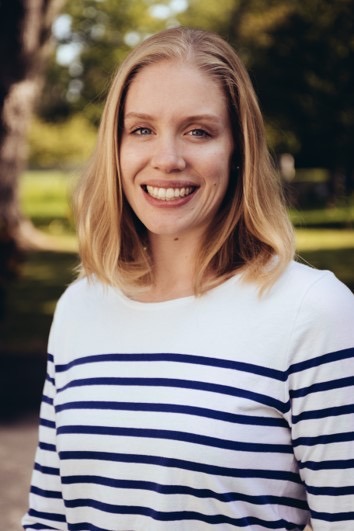In this series, I interview circular economy expert Katie Whalen about circular economy principles companies can use when designing products, and consumers can look for when buying products. This is part 1.
Listen to the full episode on Getting in the Loop.
What does circular economy mean?

Rebecca: What does circular economy mean?
Katie: In the society that we live in we have a linear society. We take resources from the ground and we extract materials, minerals, and metals. We take them, we make them into components and then we put them into products. Then these products, we distribute at mass scale across the globe. Products like phones, for example.
We treat these things as disposable. So we just send it to a landfill. You put it in the trash and then it ultimately ends up as waste in a landfill, sitting there for who knows how many years.
In Sweden, we put it in the recycling bin it or something like that, and it might actually become incinerated. So we may have some energy that we get back from it. This a linear way of doing things. We treat things as disposable and then we go out and we make new products. Going back to those mines, taking new materials and doing the whole thing over again.
The circular way is the opposite of this. It’s saying that there is still a lot of value left in things when we’re done with them. So when we see waste, then that’s not the case actually.
For example, my phone is two years old and I want to upgrade to a new model. There’s still a lot of value in that old phone because you can resell it or recycle it and actually get back some of those materials that could then be reused and made into new things.
From waste to value
So we’re saying that this linear way of doing things doesn’t make sense. There’s still a lot of value and we should be able to like rethink how we are using things and extend their lifetimes.
Rebecca: That is what appeals to me about the whole concept because we’re taking these things from nature. Maybe it’s my Swedish background, but I really value nature. So I don’t want to take more than we can use.
Then there’s also the economic part of it where it does seem like there’s still value in it. So for these companies, if to be able to take things back, for example, a phone, then they don’t need to buy these new pieces. If those things can be recycled and used again, whether it’s that the company uses it or they send it off to a third party. It seems like there is a lot of economic value that could be created from just the concept in general if more companies started to embrace this idea.
Katie: One of the things that we see in a circular economy is that waste doesn’t exist. There’s the saying waste is food and it goes back to nature.
Ken Webster, one of my favorite thought leaders on the circular economy gives the example of a cherry tree. (See video below.) If it blossoms and then the leaves fall to the ground where they’re sucked up by the soil as nutrients to sort of help the tree grow further. And so that’s this cycling idea. That’s why it’s called circular economy, because we’re trying to think about how we can have things be outputs and waste things from one source can actually become food or inputs for new sources.
Circular Design Concepts
Rebecca: Would you say this goes back to the original design? Is there a design aspect where we need to design things to be recycled or to be taken apart again?
Katie: Design definitely plays a major role in multiple aspects. I’ll unpack that if you’re OK with that.
Rebecca: That’s what I think people are interested in.
Katie: Before I do that I’ll explain that in the research we’ve been doing at Lund, there’s this idea of two main strategies that you can do for contributing to a circular economy of these from a business perspective. One is slowing loops and the other is closing loops. And this is the only circular economy jargon and I’ll use.
Think of slowing loops as extending the useful life of products and closing loops as extending the useful life of materials and resources. That’s pretty much the basics.
Slowing the Loop
Back to that phone example. So if you were going to have slowing, you would repair rather than replace the phone.
Rebecca: Like repairing the screen?
Katie: Exactly.
So repairing the screen or changing the battery. So it’s basically extending the useful life of that phone. There design plays a major role because one of the things that I have my students do in this class that I teach on eco-design is they actually try to disassemble phones and see how long it would take them to replace the batteries on certain types of different models of phones.
It’s really easy if there’s a FairPhone. It’s a company that’s based in the Netherlands and they’re trying to incorporate this type of thinking more into their design.
They are more like a really old phone. Think of old Nokia’s where you can just pop the back off.
Rebecca: I remember those. You drop it and then all the pieces fly everywhere.
Katie: Yeah. And then you can put it back together quite easily. Less high tech.
So there are other models though that you have to first warm-up this special little thing that looks like a doormat that you would block out drafts under a door. Then you have to like put them in the microwave and then put that over the phone before you can even open it. Because of the glue that is stuck together to like. It’s very complicated and there are many different steps. And usually in 30 minutes for certain models of different types of phones. Some of my students can’t even get the battery out after 30 minutes.
Rebecca: Interesting.
Katie: So I think that shows us a little bit that design plays an important role
Closing the loop
And then we talked about I mentioned closing loops as well. I always like I show a photo of all these little phones sitting in our drawers collecting dust.
Rebecca: Yep. I have one of those.
Katie: I’m also guilty of it myself.
Rebecca: There’s no incentive to give it back.
Katie: If we had incentives to actually hand in our phone, if we would actually get a rebate or something for it, then that would actually contribute to closing resource loops. The phones could then be recycled.
Rebecca: Fascinating. So that’s a lot of value that’s just sitting there.
Katie: That’s a lot of value. That’s just sitting in our drawers, collecting dust.
About Katie Whalen
Katie is working on her Ph.D. in circular economy at Lund University in Sweden. She is studying secular businesses and how businesses can create new types of value in a circular economy. She is also studying how businesses can help with the transition to a more circular economy.
She also has a podcast called Getting in the Loop that’s focused on circular economy. She also invented a game about circular economy called In the Loop. You can learn more about Katie on In the Loop Games or listen to Getting in the Loop podcast.
Minute 21 – What does circular economy mean?
Minute 24 – Designing products to keep value
Minute 27 – FairPhone
